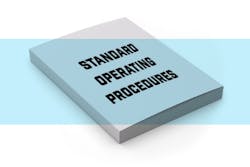Gullo Ford of Conroe had a glut of cars in its parking lot nearly every day. It was driving Billy Coleman nuts.
Customers’ cars occasionally got blocked in. There was often confusion over whether a vehicle in the lot was associated with the Conroe, Texas, facility’s body shop or its service department.
When it came to parking customers’ cars, there was nothing standard about the procedures at the dealership, which handles around 375 total ROs per month among all repair departments. That is, until early 2016, when Coleman, the collision center manager, began to overhaul the facility’s SOPs, including that disorganized parking lot.
“We had to make some changes in the [parking] flow,” Coleman explains, “and we put them in SOPs to make sure everybody understood.”
The purpose of an SOP, or “standard operating procedure,” is to provide a written document that outlines specific steps for completing a task, so that any staff member can carry out that duty in a quality, uniform fashion. An SOP serves as a key step in the process of developing—and implementing—new procedures at shops, and such a document can help facilitate training, providing employees with a reference.
An SOP, in Coleman’s nearly 43 years of industry experience, helps get everybody on the same page, so your shop can produce more cars at a more profitable rate.
The Problem
Beyond the parking lot, other areas at Gullo Ford also required standardization. The detail area especially irritated Coleman, the facility’s body shop manager for the better part of two decades.
While the detail area typically utilizes a fairly entry-level employee, it’s nevertheless imperative that detailers perform top-notch vehicle cleaning work—and address all their duties thoroughly—so customers are left with a sterling first impression once they arrive on your lot. The detail employees were also partly responsible for the parking lot issues, as they haphazardly parked cars that would eventually get blocked in by vehicles that were just arriving.
Customers seemed to take note, too, judging by the fact that Gullo Ford’s CSI scores had dipped slightly.
The Solution
Coleman eventually came to the conclusion that he needed to restore order, with updated “how-to” documentation that clarified a few processes for his 20-person body shop staff.
After all, Gullo Ford had SOP instructions in place for several other elements of the company, such as the front office, estimators and CSRs. Thus, it only made sense to have similar, detailed checks and balances for other areas, in an effort to ensure facility-wide efficiency and standards.
Considering Coleman has kept virtually every SOP he has ever written, he’s well versed in the prerequisites for creating a document that inspires business improvements. Here are some of the keys for creating quality SOPs that Coleman kept in mind when he revised his facility’s SOPs in 2016:
Keep it simple. Coleman, who worked on shop floors for 21 years earlier in his career, says it’s important not to write overly detailed instructions when creating an SOP.
“It needs to be the bullet points,” he says. “I’ve seen some of them written where it’s so detailed that it seems like it would take 45 minutes just to take the car in. You want something that’s to the point.”
Be realistic. Before writing an SOP, it’s important to study your shop’s production levels, and gauge what might be considered practical output. Then you can better spell out the goals of each repair.
You want to provide written instructions for a standardized work process, Coleman notes, so you can garner roughly the same production out of each employee.
Be mindful of staff demographics. At Coleman’s facility in Texas, roughly one-third of the staff speaks English as a second language. Coleman consults with bilingual crew members when creating SOPs, and also makes sure to keep the instructional documents concise, making sure they’re understandable for all.
Use industry resources. Coleman noted long ago that vendors like Sherwin-Williams produce SOPs that thoroughly describe paint jobs’ technical aspects. So, rather than waste his time mirroring those SOPs, he simply uses the vendor’s data sheets for his paint-related SOPs.
Archive it. At Gullo Ford, a human resource employee keeps copies of each SOP, as does Coleman for the body shop. And, employees aren’t just given a printed copy of the appropriate SOPs, but they’re emailed them, too, meaning the documents have a lengthy shelf life.
A plus with regard to saving SOPs as a manager: If you feel compelled to write up, or even fire, an employee down the line, you have documented proof of what their work expectations were.
Revisit as necessary. Coleman audits SOPs periodically (often at two-year intervals), taking note of any instructions that need to be updated or edited. If necessary, he’ll occasionally pull out an SOP during a staff meeting, noting a recent oversight on his shop floor.
“I update them as I see weaknesses on the floor,” he says. “When we change them or roll them out … I ask for input, for [employees] to tell me what they think needs to be changed.”
The Aftermath
Not long after Coleman created refined SOPs that largely centered around the detail area, Gullo Ford experienced multiple improvements.
The Texas facility went from 160 ROs per month on the collision side to 380 all told (including all departments).
In the parking lot, each body man has the vehicles they’re set to work on parked in a dedicated area. Vehicles are backed into parking spots with care―straight in, with the wheels lined up just so, as Coleman prefers. Vehicles are inspected to make sure that no spare parts are left in any compartment, and that all compound, tape and body materials are removed from all areas of the vehicle. Additionally, employees keep a close eye out for imperfections like swirl marks after a vehicle is detailed.
Since then, Gullo Ford’s CSI score improved from approximately 94–98, and the body shop ended up doing $6.04 million in total sales in 2016.
The Takeaway
Coleman has authored numerous SOPs in his career. And, his SOP revisions in 2016 offered a key reminder: When creating how-to documents for your staff, it’s important not to overthink things.
“Don’t let it consume you,” Coleman says of creating an SOP. Don’t “think that you’ve got to put everything down that you can possibly think of. It’s better to keep it as condensed as you can.”

